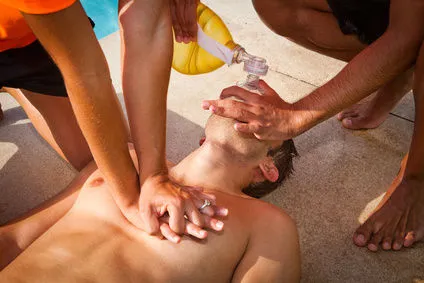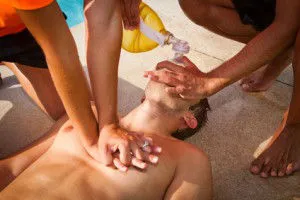
- Share on Facebook76
- Share on Pinterest
- Share on Twitter
Think about what you would do in an emergency situation. Would you jump forth and be competent at performing a life-saving technique or would you stand there helpless while the victim slowly slipped into unconsciousness?
Unfortunately, 70 percent of Americans either don’t know how to perform CPR or have let their former training lapse. Perhaps the most troubling aspect of this statistic is that this life-saving technique can double or even triple a cardiac arrest victim’s chances of survival when performed immediately. And since 88 percent of cardiac arrest episodes happen in the home, a loved one’s life can depend on the family’s CPR education.
Yet still so many people are unsure of what to do in the event of an emergency – perhaps it takes a real-life experience to get the point across. No one knows this better than Lauren Haller who was a junior in high school when her father got a phone call that changed their lives.
Lauren documented the experience in an article she wrote for her hometown newspaper. She recalls how her mother went into cardiac arrest while playing soccer and it was thanks to the quick actions of a few members on the opposing team that she survived the episode as they quickly sprung into action while waiting for the ambulance to arrive.
“Ninety-five percent of people who have cardiac arrests outside of a hospital and do not receive CPR within the first six minutes die. My mom is alive because of the decisive actions of the two opposing players,” Lauren wrote and credits quick CPR with saving her mother’s life. Today Lauren and her family are advocates of teaching CPR and basic first aid to everyone, since they saw first-hand how it made all the difference.
And while cardiac arrest is perhaps one of the first things people think of when it comes to a life-saving technique, understanding basic first aid can also mean the difference between serious injury and just a few scrapes.
According to the American Red Cross, there are several “must-haves” for every first aid kit and these should be located in every office, home and car. They include:
- Instant cold packs
- Alcohol or sanitizing swabs
- Sterile gauze
- Hand sanitizer
- Gloves
- Tweezers
- Triangular bandages for stabilizing a limb
- Elastic and adhesive bandages
- Antibiotic ointment
- Tape
- Aspirin or other pain relievers
They also recommend clear directions for CPR, mouth-to-mouth resuscitation and unblocking an airway, noting that in the event of an emergency you shouldn’t attempt to rely solely on your memory. These directions should be easy to access and clearly legible.
 Another key component to performing successful first aid is devising a practiced plan of action. In the event of an emergency, adrenalin, fear and other emotions can quickly lead to panic. Reviewing a plan of action regularly both at home and the office can prevent precious seconds from slipping away.
Another key component to performing successful first aid is devising a practiced plan of action. In the event of an emergency, adrenalin, fear and other emotions can quickly lead to panic. Reviewing a plan of action regularly both at home and the office can prevent precious seconds from slipping away.
Both basic first aid and CPR classes can be the difference between life and death. Your local Red Cross provides lists of courses and locations as well as online videos, tutorials and instruction. Don’t put off learning these life-saving techniques as the next person who requires them may just be a loved one.
-The Alternative Daily
Sources:
http://www.thefirstaidzone.co.uk/first-aid-facts
http://www.redcross.org/take-a-class/program-highlights/cpr-first-aid
http://mkt.medline.com/clinical-blog/channels/clinical-solutions/three-basic-principles-and-must-haves-for-first-aid-preparedness
http://www.dailygazette.com/news/2013/may/10/0510_SGHaller
http://www.heart.org/HEARTORG/CPRAndECC/WhatisCPR/CPRFactsandStats/CPR-Statistics_UCM_307542_Article.jsp#
- Share on Facebook76
- Share on Pinterest
- Share on Twitter

